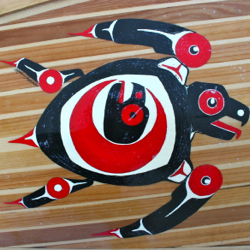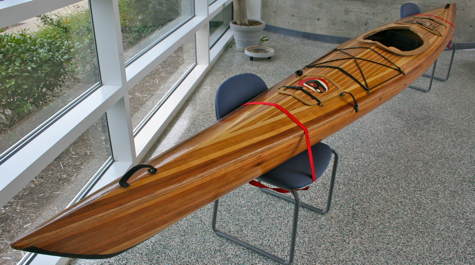VIMS grad students raffle handmade kayak to support research
Graduate students at the Virginia Institute of Marine Science are raffling a handmade kayak to raise funds for research by Masters and Ph.D. students in the School of Marine Science at VIMS.
The 17-foot kayak, painstakingly built by VIMS professor Jim Perry, is made of red cedar, white poplar, and mahogany. It includes design elements—painted by Artist Karen Aneiro of Barhamsville, Virgina—that are modeled after the totem of the Algonquin tribes of eastern Virginia to represent the journey of hatching sea turtles as they follow the moon into the sea.
 Ph.D. student Lori Sutter, chair of the fundraising
committee for the Graduate Student Association (GSA) at VIMS, says “This is a one-of-a-kind
boat that is both beautiful and utilitarian. It’s been varnished with
polyurethane to retain the color of the wood and to protect it from UV damage,
and includes both fore and aft watertight hatches for storage.”
Ph.D. student Lori Sutter, chair of the fundraising
committee for the Graduate Student Association (GSA) at VIMS, says “This is a one-of-a-kind
boat that is both beautiful and utilitarian. It’s been varnished with
polyurethane to retain the color of the wood and to protect it from UV damage,
and includes both fore and aft watertight hatches for storage.”
Tickets for the GSA-hosted kayak raffle are $10 each, with discounts for multiple purchases (5 for $40, 10 for $75, and 15 for $100). Tickets can be purchased by sending an email to [[gsafunds]]. The raffle organizers will coordinate payment and send participants an electronic receipt and scanned ticket stub.
The winner of the kayak raffle will be chosen in a random drawing during VIMS’ annual community yard sale on August 25, 2012—another fund-raising effort organized and hosted by graduate students at VIMS. Participants need not be present to win. The yard sale, which is open to public, takes place between 7:30am – 1:30pm on the VIMS campus in Gloucester Point, just across the Coleman Bridge from historic Yorktown.
VIMS graduate students are a key part of the Institute’s mission of research, education, and advisory service, conducting studies that provide the knowledge needed to protect and restore Chesapeake Bay and its marine life. Their studies extend from the Bay and its watershed to the open ocean, with primary emphasis on estuarine and coastal science.
Andre Buchheister, a Ph.D. student studying the environmental factors that influence the Chesapeake Bay fish community, chairs the GSA “mini-grant” program that disburses funds from graduate-student fundraisers. He notes that the program, conceived and operated by VIMS grad students, has provided up to $500 in research support to 19 different Master’s and Ph.D. researchers during the last 5 years, for a funding total of $9,128.
A previous GSA kayak raffle, in 2011, supported research by five students, including studies of how the size and shape of restored oyster reefs affects their performance and ecological function (Allison Colden, Ph.D.), how sea-level rise is altering the ecology of tidal marshes (Lori Sutter, Ph.D.), how variability in the condition of juvenile summer flounder affects their survival (Ryan Schlosser, Ph.D.), how uncertainty in sampling affects the assessment of fish stocks (Catarina Lima, MS), and how organic carbon cycles through freshwater ecosystems (Christie Pondell, MS).
Dr. Linda Schaffner, Associate Dean of Academic Studies at VIMS, says the kayak raffle and mini-grant program are “wonderful examples of our students’ get-it-done attitude, enthusiasm, and skills in research.” “The GSA officers have been very proactive in raising funds for research,” she says, “while writing their mini-grant proposals and deciding which ones to fund provides practical skills that they’ll use throughout their careers in marine science. Our students go on to jobs in education, government, and the private sector.”
Perry first became interested in building watercraft while watching his father construct a fishing boat in Rhode Island in the 1950s. He started building his own kayaks about five years ago, and has now completed five hand-made vessels. He estimates that his latest creation required 200 hours of effort over the course of a year, including 2 weeks of sanding.
“I’ve always wanted to build boats,” says Perry, “and finally have the space. I really love doing it, and I also really enjoy supporting our students. They’re the future and I want to help them succeed in any way I can.”




